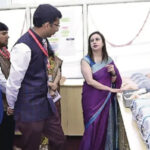The global head of edtech implementation at Inspired Education explains why the group embraced the VR metaverse and now uses it in subjects from biology to history
For years virtual reality was touted as a future game-changer in education – but it never quite took off, even with a pandemic that forced learning online across the world.
However, virtual reality (VR) has been very much part of our students’ learning experiences at Inspired Education Group since 2022. This began when we used VR to ensure that students at our international online school Kings InterHigh could conduct science experiments as required for their International Baccalaureate (IB) Diploma Programme.
First we commissioned an application to be built in the metaverse – the term used to describe anything hosted within VR – and then trained our IB teachers in how to use it on a Quest 2 headset. Students on the IB Diploma were then also required to have access to a VR headset.
With this in place, lessons could go ahead – to great success: students logged in to witness experiments and then conduct them too, all within the VR environment.
Widening use of VR in schools
From this we began considering how else we could use VR and looked at other applications on the market.
While many applications were interesting, it became clear that asking teachers and students to use different apps from different providers would be inefficient. Equally, many apps did not align with our teachers’ needs and objectives.
Therefore, we decided we would develop our own apps to ensure that content was relevant to teachers and their subjects. To do this we worked first with an external company called VictoryXR to create bespoke content and see what was possible before bringing this development in-house.
We now have five dedicated professionals building tools – all but one of whom has prior teacher experience. This ensures that we always work from the perspective of what teachers truly want from this technology: what it should achieve, what it should avoid and what will be valuable.
With this guiding our work, we have now created more than 250 different learning experiences, including the following:
- In history, travelling to ancient Egypt to see the Pyramids, experiencing life in the trenches as a soldier in the First World War, and seeing Napoleon and his army at the Battle of Waterloo.
- In biology, “dissecting” a human heart or a sheep’s lung.
- In art, students can “talk” to VR versions of artists such as Picasso, and engage in mixed-reality art to mix real-life canvases with virtual techniques.
- In languages, students can meet online to practise different languages with one another.
We also produced numerous tools to support teachers, such as training sessions, step-by-step lesson guides, booking tools, presentations, videos and other resources to make metaverse lesson planning easier and more effective.
Teachers and students can access one-to-one training sessions if they require them, so they are equipped with not only with the technical skills necessary to use the equipment but also the pedagogical framework to integrate it in a meaningful way.
Rolling out the hardware
Of course, developing the software was one thing – we also had to get more than 2,000 headsets into over 80 countries. However, my experience in school leadership was invaluable, as I worked closely with providers, IT teams and our finance department to ensure that everything ran smoothly.
A key part of this process was negotiating directly with the provider without any intermediaries. This allowed us to get exactly what we needed without delays, and to have clear oversight of the process.
Furthermore, clear communication and coordination were essential so schools knew what was happening and that they had to work with us to integrate this technology into their classroom as every student from Year 7 onwards would be using the equipment.
It was a lot of work but we now have devices in 83 schools and 250 different lessons available in the library, across all subjects and divided into key academic or co-curricular departments.
The impact
While we were confident in the impact of the VR technology, we also wanted data to back this up. So when it was first rolled out we asked students and teachers to fill out a feedback form on how they found it all.
So far this has shown huge positives – 90 per cent of students reported increased engagement and interest in their lessons, and 85 per cent of teachers found virtual and mixed reality to be a valuable tool to enhance their teaching.
In addition, 72 per cent of students and 85 per cent of teachers said using VR helps them to recall information.
Based on feedback, we have also tailored VR and mixed reality experiences to accommodate different learning preferences. To better support hands-on learners, we have introduced more interactive elements, while also incorporating additional guided explanations for those who benefit from structured instruction.
We have enhanced our teacher training programmes by offering more workshops and on-demand resources to help educators integrate VR effectively into their lesson plans.
Additionally, to ensure inclusivity, we are actively working on making VR experiences more accessible by adding closed captions, audio descriptions and adaptive controls for students with disabilities.
Overall, the adoption of metaverse technology into our teaching methods has indicated extremely positive outcomes.
What’s especially exciting is that this is a technology that is still very much in its early stages, meaning there’s no end to the possibilities it could offer to enhance the learning experiences of young people in ways that were once unimaginable.
Quelle:


